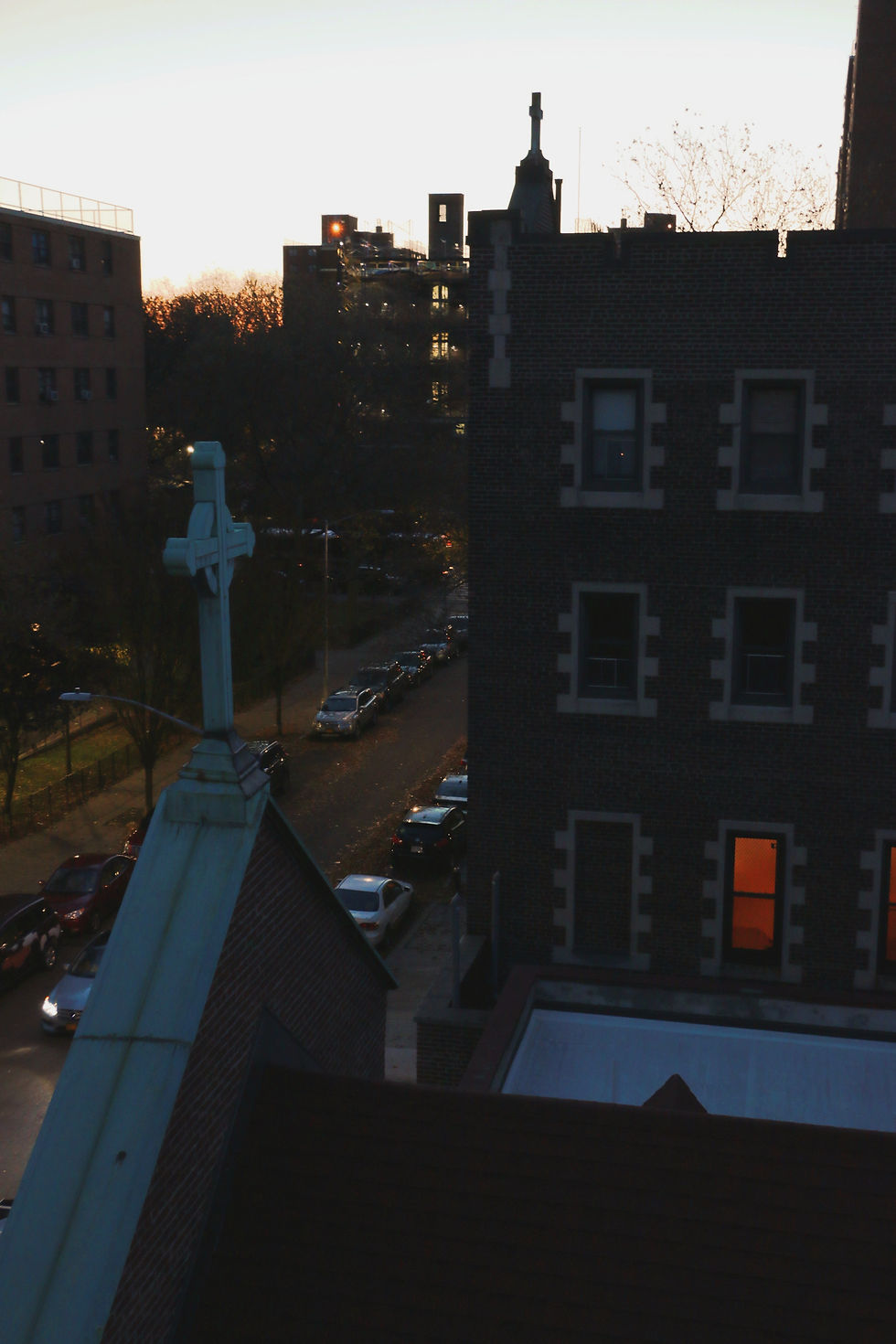Tenebrae: There is Light in the Darkness, there is Hope
- CFR Sisters
- 14 minutes ago
- 5 min read

5:25 a.m. The stark clatter of wood on wood. The bells fell silent at Mass yesterday evening and will not ring again until tomorrow night. Hushed footfalls and a rustle of paper only seem to augment the profound silence of this morning. One by one, candle in hand, we take our places in the chapel; the small flickers of flame echo the light of the seven tall candles on the altar. Otherwise, all is wrapped in darkness.
It is Good Friday, and the Tenebrae service is about to begin. What is Tenebrae? To begin let me explain the Liturgy of the Hours. The Liturgy of the Hours, or Divine Office, is a prayer (really a number of prayers) prayed by all priests, deacons, religious sisters and brothers and many laity throughout the world.

It is a way to sanctify the day, by praying at different times of the day: dawn, morning, midday, evening, night…even mid-morning, mid-afternoon and mid-night if you are a contemplative monk or nun. Each of the Liturgies includes psalms, a Scripture reading and a hymn, with a few other prayers depending on the time of day. The first “hour” that we sisters pray together, at 6 or 7 am, is Office of Readings, which includes two longer readings-from Scripture and the Church Fathers. Usually, we pray Morning Prayer after an hour of private meditation time.
Why do I mention all of this? Because the Tenebrae service consists of Office of Readings and Morning Prayer joined together, but with a few special additions. It is prayed by candlelight. After each psalm, one candle on the altar is extinguished, so the light slowly diminishes. There was a practical beginning to this. Back when everything was done by candlelight, when the monks in the monasteries prayed the lengthy Office on Good Friday morning, as the prayer went on, dawn would break, and they would extinguish unneeded candles. Over time, however, this took on another significance. The diminishing candlelight became a reminder of the seeming triumph of evil when Jesus Christ was crucified and died. The Office took on a mournful tone as the passages from the Lamentations of Jeremiah were sung after the readings. Toward the end of the service the monks would even bang their choir stalls (seats) with their prayer books, to re-enact the earthquake which happened at the time of Jesus’ death. We now use what is called a “clacker,” a small wooden mallet that strikes a wooden board, both for the earthquake and to call us to prayer between Holy Thursday evening and the Easter Vigil, during which time no bells are rung. From the monasteries these beautiful traditions have come to us, tangible reminders of the Lord’s Passion as we pray the Divine Office.
So, Tenebrae. The chapel is silent and dark, except for the flicker of the candles. Office of Readings begins with an opening verse, an initial psalm with a response, and then a hymn. Then we pray the first psalm. There is a pause. One sister goes to the altar, bows and extinguishes the candle on the far left. A wisp of smoke rises, barely visible in the trembling light. The second psalm is prayed. The candle on the far right is put out, sending up its trail. The third psalm, the third candle. The third wisp of smoke seems to speak ominously—of the Lord’s enemies closing in. A sister moves to the front, stands to the left of the altar and reads the Scripture passage from the Letter to the Hebrews: “When Christ came as high priest of the good things which have come to be, he entered once for all into the sanctuary…not with the blood of goats and calves, but with his own blood…” (Heb: 9:11).

Following this, another sister takes her place at the front to sing a passage of Jeremiah’s Lamentations: “How lonely she is now, the once crowded city…” (Lam. 1:1). “Jerusalem, Jerusalem,” we respond, “return to the Lord your God.” Then the second reading, by St. John Chrysostom, is read and another passage of the Lamentations sung. Office of Readings moves seamlessly into Morning Prayer. Almost imperceptibly, the darkness outside has melted to grey. A bird breaks into song.
Three more psalms are prayed, three more candles extinguished. Only one now remains glimmering on the altar, the Christ Candle. “So marred was his look beyond that of man, and his appearance beyond that of mortals…” (Is. 52:14) we hear in the reading, and in the response: “I am a man who knows affliction…one whom he has led and forced to walk in darkness, not in the light…” (Lam. 3:1-2). We stand to chant the Benedictus, the Canticle of Zechariah. “Over his head they hung their accusation: Jesus of Nazareth, King of the Jews,” (Mt. 27:37) a sister intones. “Blessed be the Lord the God of Israel…” (Lk. 1:68). The single candle on the altar is a point of hope amid the shadows. “He has come to his people and set them free,” we sing, “…in the tender compassion of our God the dawn from on high shall break upon us, to shine on those who dwell in darkness and the shadow of death…” (Lk. 1:78-9). The last words of the Glory Be fade to silence, and the Servant (Superior) goes to the altar, bows, and carries the Christ Candle out of the chapel. All of us, excepting the prayer leader, blow out our candles. Only the dusky first light mitigates the shadows that fill the chapel. A desolation seems to hover over us.
There is a tradition in some countries, including England and Ireland, to add a fifth candle to the Advent wreath. It is white and is placed in the center of the wreath. This candle, also called the Christ Candle, is lit on Christmas day, joyfully announcing that Jesus, the Light of the World has been born. On Good Friday morning, when the Christ Candle is carried from the chapel, it is as if the last page of the story that began in Advent has been read and the book closed.
Morning prayer continues simply, with the intercessions and the Lord’s Prayer. The glow
of dawn steadily rises. After the concluding prayer, we remain standing. Once more the Servant quietly leaves the chapel. Once more comes the jarring sound of wood striking wood, evoking the earth’s trembling at the death of Our Savior. Still, we stand. Then, a gleam in the doorway, and the Christ Candle is carried back in and set on the altar. There is light in the darkness, there is hope. The birdsong outside has swelled to a chorus. It is true: Love is stronger than death. Tenebrae is finished, and the convent remains enveloped in reverent silence. We will repeat this tomorrow, Holy Saturday morning, with different psalms and readings and prayers.

Again, at the end, the Christ Candle will remain—a prelude to the glorious radiance that will cleave the night at the Easter Vigil as the deacon sings, “Christ, our Light!” and the Paschal Candle is carried in triumphal procession to the altar. Jesus’ Resurrection brings a light that will never pass away.
“Thanks be to God!”
-Sr. Cecilia, CFR


